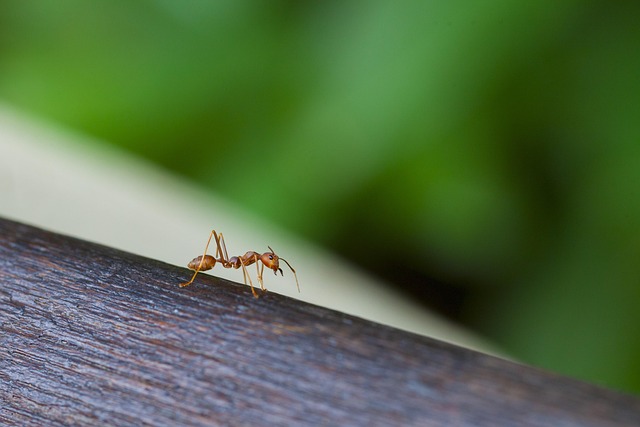Ant infestations can be managed through understanding their causes, which include cracks, gaps, food sources, and suitable habitats. Effective prevention involves regular cleaning, sealing entry points, strict sanitation, and tailored strategies based on species' preferences. Proactive measures like clutter removal, sealed entry points, food storage in airtight containers, and prompt spill cleanup form a robust defense. Seasonal deep cleaning disrupts breeding cycles. For severe infestations, professional ant control services using eco-friendly methods are recommended to address root causes.
Keep your properties ant-free with effective maintenance plans. This comprehensive guide delves into understanding ant infestations, their causes, and common entry points. We explore proactive measures like creating an uninviting environment for ants and effective cleaning practices to disrupt breeding cycles. Additionally, learn when and how to seek professional ant control services for complete ant infestation removal. Implement these strategies for sustained protection.
Understanding Ant Infestations: Causes and Common Entry Points
Ant infestations can be a persistent and frustrating problem for homeowners and property managers alike. Understanding the causes behind these invasions is the first step in developing an effective maintenance plan for ant infestation removal. Ants are highly adaptable creatures, often seeking out food sources and suitable habitats within structures. Common entry points include cracks in walls, floors, or foundations; gaps around doors and windows; and even pipe openings. These tiny invaders can swiftly establish colonies, multiplying rapidly and causing significant disruptions to homes and businesses.
By identifying the specific species of ants infesting a property, one can tailor prevention strategies more accurately. Some ant species prefer sweet substances, while others are attracted to proteins or greasy materials. Regular cleaning routines, sealing entry points, and maintaining proper sanitation practices are essential components of an ongoing maintenance plan. Implementing these measures can significantly reduce the risk of ant infestations and provide a more comfortable living environment.
Proactive Measures: Creating an Uninviting Environment for Ants
To effectively prevent and manage ant infestations, proactive measures are key. Creating an uninviting environment for ants starts with maintaining a clean and clutter-free space. Regularly cleaning floors, especially in kitchens and dining areas, helps eliminate food debris that might attract ants. Additionally, sealing entry points such as cracks, gaps, and window sills with caulk or weather stripping prevents ants from finding their way indoors.
Removing sources of moisture is another crucial step. Ants are drawn to water, so addressing leaky pipes and ensuring proper drainage around the property can significantly deter them. Moreover, storing food in airtight containers and promptly wiping up spills ensures that even if ants do find a trail, they won’t be led to a food source. These proactive measures, combined with regular inspections, form a robust defense against ant infestation removal.
Effective Cleaning Practices to Disrupt Ant Breeding Cycles
Effective cleaning practices are integral to disrupting ant breeding cycles and preventing ant infestation removal. Regularly vacuming floors, especially in areas with food debris or sticky residues, helps eliminate ant trails and pheromones that guide other ants to food sources. Mopping hard surfaces with a combination of warm water and mild detergent can effectively wash away ant eggs, larvae, and adult ants hiding in corners and crevices. Additionally, cleaning up spills promptly and storing food in airtight containers reduces attractants and disrupts the ants’ access to viable nesting grounds.
Focus on thorough cleaning, especially in kitchens and dining areas where ants are most likely to breed. Wipe down countertops, clean under appliances, and sweep floors daily to remove crumbs and other ant food sources. Seasonal deep cleaning, including scrubbing baseboards and mopping hard-to-reach areas, further disrupts ant breeding cycles by eliminating hidden nests and egg sacs. By maintaining a clean environment, you make properties less hospitable for ants, reducing the need for frequent ant infestation removal measures.
Professional Ant Control: When and How to Seek Expert Help
If an ant infestation persists despite your best efforts, it may be time to seek professional help for ant control. Ant infestations can quickly spiral out of control, and professional services have the expertise and tools needed to tackle even severe cases effectively. Look for pest control experts that specialize in ant infestation removal, as they understand the specific behaviors and habits of various ant species.
When hiring professionals, ensure they employ safe and eco-friendly methods, especially if you have pets or children at home. Modern ant control techniques often involve less harmful chemicals, such as natural repellents or targeted insecticides, minimizing risks while effectively removing ants from your property. A professional assessment will also help identify the entry points and nest locations, ensuring a thorough and lasting solution to your ant problem.
Ants can quickly transform from a minor nuisance to a significant property issue, but with a multi-pronged approach, homeowners can effectively manage and prevent ant infestations. By understanding their behavior, taking proactive steps to deter them, implementing rigorous cleaning practices, and knowing when to seek professional help, you can keep your properties ant-free and ensure a peaceful living environment. Remember, a strong defense against ant infestation removal is key to maintaining a comfortable home or business space.
